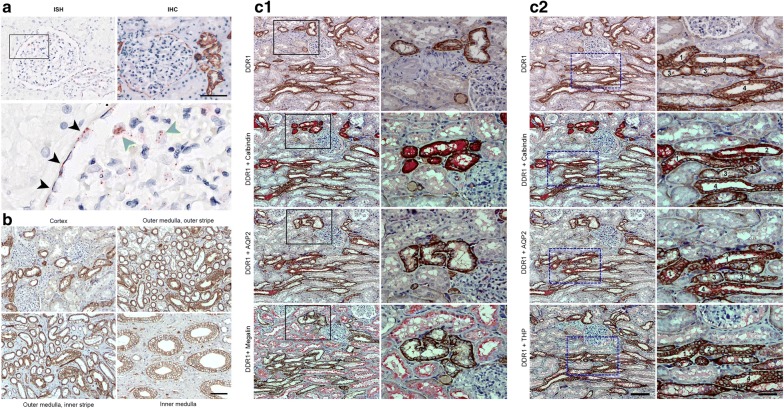Fig. 1.
Localisation of DDR1 in human control kidney. a DDR1 in situ hybridization (ISH) and immunohistochemistry (IHC) analyses in normal human kidney. (Scale bar = 100 μm). ISH higher magnification rectangle: DDR1 positive podocyte (black arrowheads), DDR1 positive podocytes (green arrowheads). b DDR1 immunostaining in the nomal human kidney with representative images of the cortex, outer medulla (outer and inner stripes) and inner medulla. Note the DDR1 membranous staining of the tubules. (Magnification ×125, scale bar 50 μm). c Serial sections of normal human kidney were double immunostained with DDR1 and specific tubular antibodies against Megalin, Calbindin, Tamm–Horsfall Protein (THP or Uromodulin) or Aquaporin 2 (AQP2). c1 Representative micrographs of the cortex show DDR1 protein localization in the distal convoluted tubules (Calbindin+, Aquaporin 2−, Megalin−). Proximal tubules (Megalin+) are DDR1 negatively stained. Boxed areas are enlarged in the right side of the figure. c2 Representative micrographs of the medullar rays of the cortex show DDR1 protein localization in the connecting tubules (1: Calbindin+, Aquaporin 2+, THP−), distal convoluted tubules (2: Calbindin+, Aquaporin 2−, THP−), thick ascending limbs of the Henle’s loop/pars recta of the distal tubules (3: THP+, Calbindin−, Aquaporin 2−) and collecting ducts (4: Aquaporin 2+, Calbindin−, THP−). Boxed areas are enlarged in the right side of the figure. Magnification ×100, scale bar = 100 μm; Boxed areas Magnification ×250, scale bar = 50 μm

